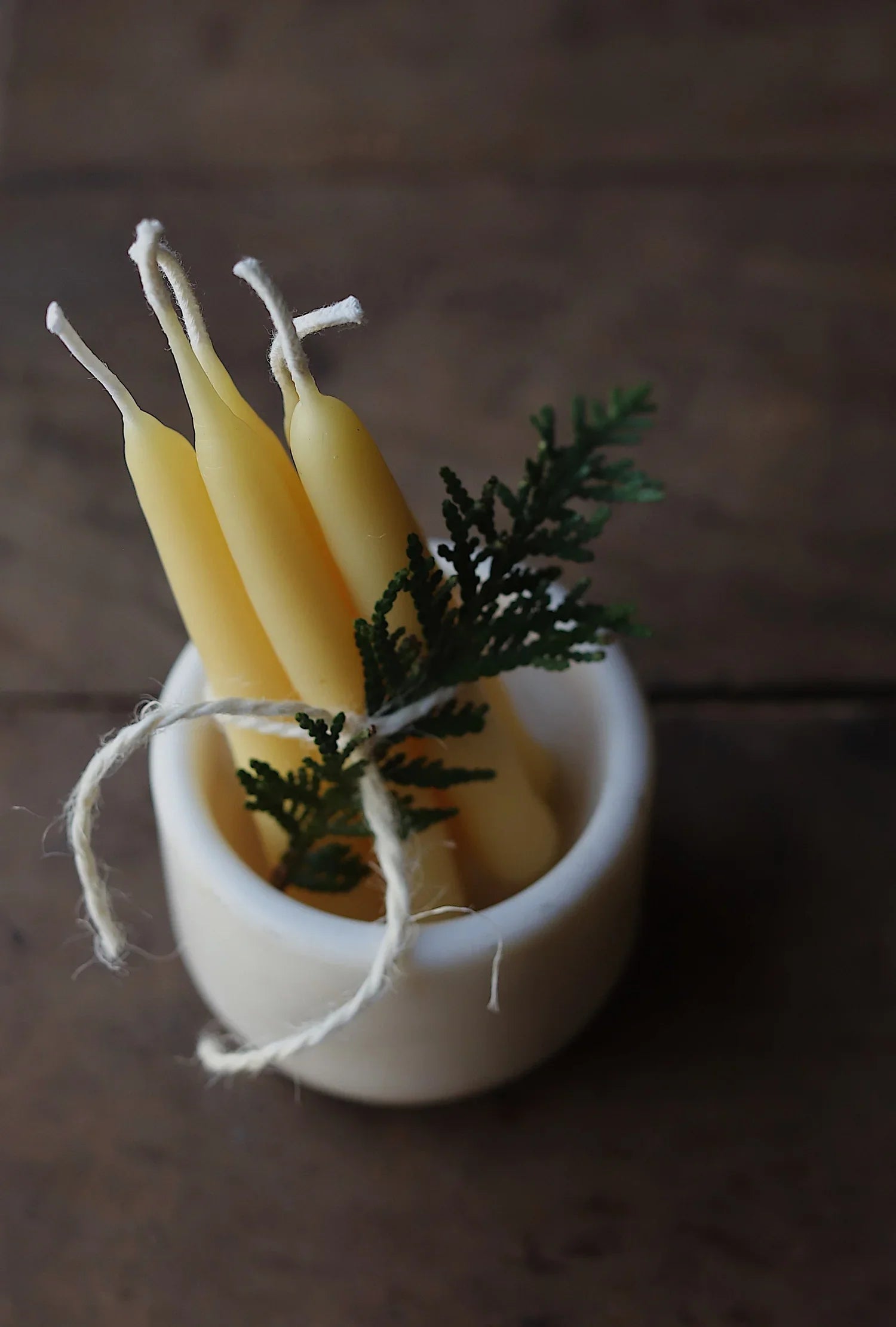
Wick Materials Candle Makers Don’t Share
Most people shop for candles based on scent, aesthetics, or jar design. But if you’re only paying attention to the outside, you’re probably ignoring one of the most important parts of the candle: the wick. It’s small, usually hidden, and rarely mentioned on labels, but the wick material directly affects how your candle burns, what it releases into your air, and how safe or toxic it truly is.
This is the part most candle makers don’t talk about, and in this article, we’re uncovering the facts. If you want a candle that’s actually safe to burn in your home, free of hidden chemicals, and designed to give you a clean burn with a strong scent, you need to understand wick materials.
Quick Navigation
- Why the Wick Matters More Than You Think
- The Problem With Metal-Core Wicks
- What a Lead-Free Wick Really Means
- Cotton Wicks vs. Wooden Wicks
- How Wick Materials Affect Indoor Air Quality
- How to Choose a Non-Toxic Wick
- Why Wick Quality Impacts Your Entire Candle Experience
- What We Use at Living Good Candle Co.
Why the Wick Matters More Than You Think
The wick is what controls how the candle burns. It draws the melted wax up to the flame, where it becomes vapor and combusts. But different wick materials affect that burn in very different ways. Some produce soot, others burn too fast or too slow, and some can release toxic chemicals into the air.
Even if a candle is made with clean wax like beeswax, a bad wick can still ruin it. If the wick core contains metal, or if the fibers are chemically treated, your candle might release heavy metals, formaldehyde, or VOCs every time you light it.
It’s not just about the flame—it’s about what that flame releases into your home. A non-toxic wick is just as important as the wax or fragrance, especially if you burn candles often or live in a small space with limited ventilation.
That’s why the best non-toxic candles focus on the entire formula—not just the wax or scent, but the wick, too.
The Problem With Metal-Core Wicks
Many cheap candles—especially mass-produced ones—still use metal-core wicks. These wicks often contain zinc or tin to keep them upright as they burn. Older versions used lead, which is now banned in the U.S., but some imported candles may still contain lead-core wicks, especially if you’re buying from unknown brands or discount stores.
Burning metal-core wicks can release toxic particles into your indoor air. Even zinc and tin can emit fine particles that are dangerous when inhaled over time, especially for people with asthma, sensitive lungs, or small children in the home.
And the problem isn’t always visible. These metals burn into microscopic particles, which linger in the air long after the candle goes out. You can’t see them, but you’re still breathing them in. That’s why even a “small” exposure over time can affect your health.
If your candle has a rigid wick that stands tall even when unburned, it could have a metal core. And that means the candle is not non-toxic—no matter what the label says.
What a Lead-Free Wick Really Means
These days, most candles sold in the U.S. are labeled lead-free, which sounds good—until you realize it doesn’t mean much on its own. Just because a candle says lead-free doesn’t mean it’s free from other metals or chemical treatments.
Some lead-free wicks still contain zinc, synthetic stiffeners, or are bleached with chlorine-based chemicals. These additives help the wick burn longer or straighter, but they can also pollute your home’s air and contribute to long-term exposure of harmful compounds.
A lead-free label can be misleading. It gives the impression of safety, but unless it also states that the wick is zinc-free, untreated, and 100% cotton, you’re still left guessing. That’s a major problem when it comes to candle safety and indoor air quality.
If you want a truly clean-burning candle, you need more than a lead-free label. You need a pure cotton wick or an untreated wooden wick—materials that burn cleanly without the need for metals or chemical stiffeners.
Cotton Wicks vs. Wooden Wicks
So which is better—cotton wicks or wooden wicks?
Both can be great, but it depends on how they’re made. The best cotton wicks are 100% organic, unbleached, and free from stiffening agents. They create a stable burn, especially with natural waxes like beeswax. But if they’re treated with chemicals or contain braided synthetics, they’re no longer truly non-toxic.
Wooden wicks, on the other hand, offer a modern look and a soft crackle sound when lit. They’re beautiful in appearance and can offer an even melt pool. However, not all wooden wicks are created equal. Some are laminated or glued, and that adhesive can release toxins when burned.
Look for wooden wicks made from untreated, FSC-certified wood, with no glue or synthetic layers. A single-ply, uncoated wood wick is one of the cleanest-burning options available—especially when paired with beeswax and plant-based fragrance oils.
And while cotton wicks tend to be more common, wooden wicks are gaining popularity with eco-conscious buyers. Their crackling sound and aesthetic appeal offer a unique experience, as long as the material is pure and untreated.
How Wick Materials Affect Indoor Air Quality
Your home’s air quality matters. Every time you burn a candle, you’re releasing gases, vapors, and particles into the air. That’s why wick materials play a huge role in whether your candle helps or hurts your environment.
When you burn a candle with a low-quality wick, it may produce visible soot. That black smudge on your wall or jar is made of particulate matter—tiny, inhalable particles that can cause lung irritation. But even if you don’t see the soot, you could still be breathing in volatile organic compounds from the wick additives.
Poor air quality has been linked to allergies, headaches, and even sleep issues—all of which can be made worse by burning toxic candles. If your goal is to make your home smell better, a bad wick can do the opposite. It can actually make your air more polluted.
Candles with high-quality wicks, however, burn with minimal smoke, no soot, and no off-gassing. Combined with clean waxes like pure beeswax, a good wick supports your overall wellness instead of compromising it.
How to Choose a Non-Toxic Wick
If you want to buy non-toxic candles that are safe for your home, you have to start reading labels differently.
Unfortunately, most candle makers don’t list the wick material. It’s one of the most overlooked ingredients on the market, and most brands rely on customers not asking questions.
At minimum, look for brands that use 100% cotton wicks, wooden wicks made without glue, and untreated, lead-free, zinc-free materials. Better yet, choose candles from companies that specialize in non-toxic candle ingredients, like beeswax, plant-based oils, and chemical-free wicks.
And don’t stop at the product label—check the company’s website. Look for detailed descriptions of their wick choices, fragrance sources, and wax types. The more transparent the brand, the more likely it is that their candle is truly non-toxic.
Why Wick Quality Impacts Your Entire Candle Experience
Wick quality doesn’t just affect safety. It also affects the burn time, scent throw, and appearance of your candle. A bad wick can cause tunneling, uneven burns, or a weak scent—even if you’ve bought a candle made with premium wax.
A well-made wick ensures that the wax melts evenly, releasing the fragrance properly and creating a long-lasting burn. If you’ve ever wondered why one candle smells great for hours while another fades after 20 minutes—it’s often the wick.
The wick, in many ways, acts like the engine of your candle. It drives the combustion process, determines how hot the flame gets, and influences how far the scent travels. So if you want your candle to perform well from first light to last flicker, you need a wick that’s built right.
What We Use at Living Good Candle Co.
At Living Good Candle Co., we design our candles for people who care about what they breathe. We use 100% pure beeswax, plant-based derivative oils, and only lead-free, zinc-free cotton wicks that are free from bleach, stiffeners, or any synthetic materials.
Our wooden wicks are made from natural, untreated FSC-certified wood, giving you that soft crackle without any glues or laminates. Every element is carefully selected to support non-toxic living, from the jar to the label to the wick.
We believe in full ingredient transparency, so you know exactly what you're bringing into your home. When you burn our candles, you can breathe easy—knowing the air stays clean, the burn is safe, and the scent is pure.
Final Thoughts
The candle industry focuses so much on fragrance, wax blends, and luxury branding—but too often skips over the most essential element: the wick. If you care about your home’s air, your family’s wellness, or your own peace of mind, you can’t ignore what your candle is made from at its core.
Don’t be fooled by vague labels. Start asking questions about wick materials. Start reading past the scent name. And if you want a candle that’s truly non-toxic, safe, and beautiful, choose one that’s made with a clean wick, pure beeswax, and plant-based oils—just like we do at Living Good Candle Co.



